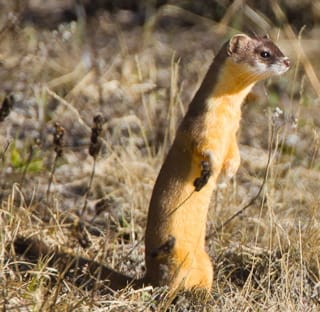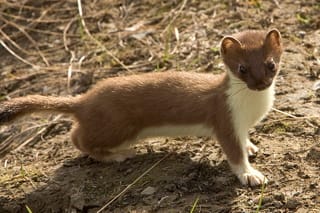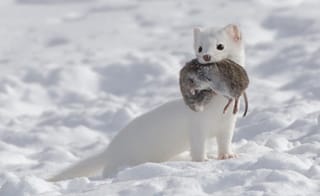This guide initially displays all common mammals. Use the selectors below to view mammals of a particular shape, include rare mammals, or search for them by name.
Mammals are defined as warm-blooded vertebrates with hair or fur and sweat glands — in the females mammary glands, modified sweat glands, produce milk to nourish the young. Most mammals develop a placenta which enables the feeding of the fetus during gestation and give birth to live young. In addition, although most mammals walk on land, many have specific adaptations that allow them to swim, fly, leap between tree branches or even dig extensive tunnels. Many wild mammals are used for both food and fur. while other have been domesticated for their agricultural and scientific importance.
New Mexico ranks high for mammalian diversity in the states in the US and the Pajarito Plateau is home to many of these species. This guide describes all of the larger wildlife found in the area as well as the more common smaller animals with the most abundant being rodents. Local species range from carnivores like the mountain lion and bobcat to ruminants like elk and deer to to several varieties of bats.
Mammal References
Biota Information System of New Mexico
Bogen et al. 1998 Continued Studies of Bat Species of Concern in the Jemez Mountains, New Mexico [PDF]
eNature
Frey et al. 2006 Checklist of New Mexico Mammals [PDF]
New Mexico Tech Mammalian Field Guide
Smithsonian National Museum of Natural History North American Mammals
Threatened, Endangered and Sensitive Species Profile – Los Alamos Laboratory Lands [PDF]
Tyrell and Brack 1992 Survey for Bats in the Los Alamos National Environmental Research Park
Subject Area Experts (all guides)
Steve Cary (butterflies)
Beth Cortright (insects)
Terry Foxx (invasive plants)
Leslie Hansen (mammals)
Richard Hansen (fish, mammals)
Dorothy Hoard (butterflies, trees)
Chick Keller (flowers, herbarium)
Shari Kelley (geology)
Kirt Kempter (geology)
Garth Tietjen (reptiles)
David Yeamans (birds)
Web Development and Content Management
Pat Bacha
Jennifer Macke
Graham Mark
Akkana Peck
Contact
Please contact us for local nature questions and sightings. We welcome comments, corrections, and additions to our guides.
For more information about local nature, please visit our Nature Blog or subscribe to PEEC This Week.
Make Selection
 Photo: Greg Lasley |  Long-tailed Weasel(Mustela frenata)Family: Mustelidae (Weasels, Badgers, and Otters) Size: 11 - 22 in (28 - 56 cm) Status: native; uncommon Habitat: forest, brushy and open areas, farmland, woodland, near water The Long-tailed Weasels are relentless and voracious predators. They follow a solitary, secretive life but can be seen both day and night hunting for vertebrates like mice or rabbits. They, in turn, are hunted by birds of prey. The Long-tailed Weasel has a long bushy tail with a black tip that is about half of its total body length. They can produce a strong, foul-smelling scent which they use to mark territory, attract mates and discourage predators. There are numerous subspecies of Mustela frenata. As depicted in the photo, many in the Southwest have dark facial masks and varying white patches on their heads. Tracks Info Photos Distribution |
 Photo: Steve Hillebrand, US Fish & Wildlife Service  Photo: redfaux |  Short-tailed Weasel, Ermine, Stoat(Mustela erminea)Family: Mustelidae (Weasels, Badgers, and Otters) Size: 7.5 - 13.5 in (19 - 34 cm) Status: native; uncommon Habitat: open woodlands, brushy areas, grasslands, farmland, towns The Short-tailed Weasel is native throughout North America and Eurasia where it is more commonly known as a Stoat. It has short, rough fur that is brown in summer (top photo) and silky, fine fur that is white in winter (bottom photo). The name Ermine is most often used to refer to the animal in its winter coat. Its tail length is about a third of its total body length and is tipped in black even in winter. The winter coat has been prized for centuries for its use a luxury fur. Short-tailed Weasels are fierce hunters, primarily catching small rodents. They will often use the burrows of the rodents they kill as their own. They will also often live in old stumps, under tree roots or vacant buildings. Tracks Info Photos Distribution |
